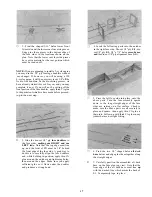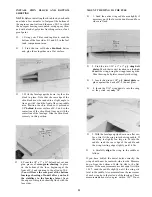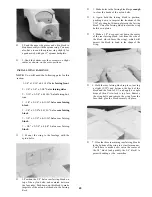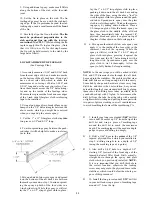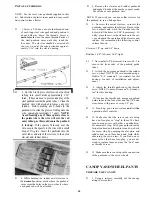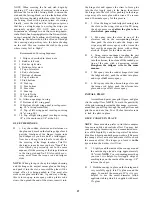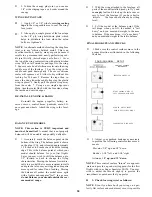
D 8. Sand one edge of the 1/4" balsa fairing front
to fit the contour of the front of the wing. With
the wing in place on the fuselage, hold the fair-
ing front in place (allow 1/32" gap between the
fairing front and the rear of the dowel plate)
and tack glue it to the wing. CAUTION: Use
extreme care to avoid gluing the wing to
the fuselage!
D 9. Glue the 1/4" balsa fairing sides to the wing
and to the fairing front.
D 10. Sand the bottom of the 3/16" balsa fairing
bottom to match the bottom of the wing, then
glue it in place.
D 11. Sand the fairings to smoothly blend the
wing to the fuselage.
MOUNT THE STABILIZER AND FIN
D 1. Lightly sand the stab saddle smooth with a
T-bar sanding block.
D 3. Measure 1/8" in from the inside edge of the
3/16" balsa fuse sides and draw two lines on
the stab saddle (see the above photo).
D 4. Drill 3/32" diameter holes, 1/2" apart, along
the lines you drew on the stab saddle. Drill
down through the aft deck base and the under-
lying 3/8" balsa triangle. NOTE: The purpose
of these holes is to permit epoxy to flow into
the holes, providing a very strong bond be-
tween the fuse and the stabilizer.
D 5. Accurately measure the trailing edge of the
stabilizer and mark the center point.
D 6. Temporarily mount the wing in the saddle
(for reference).
D 7. Lay the stab in position on the stab saddle
with the center point lined up with the tail end
of the fuselage. If the stab protrudes beyond
the end of the fuselage, sand a little off the
front of "the stab until it fits. Carefully check
the stab alignment by measuring down from
the tips to a flat surface, and from the stab tips
to the wing tips (or to a point on the center of
the fuse near the nose). Sand the stab saddle
(a little at a time!) until it rests in proper
alignment. With the stab in alignment, make
a mark on the front of the stab and a corres-
ponding mark on the back of F-6A, which will
be used for rapid alignment when gluing.
D 8. Mix up a batch of 5-minute or 30-minute
epoxy and apply it to the stab saddle. Use a
flat stick to force some of the epoxy down into
the 3/32" holes you previously drilled. Then
press the stab into position and hold or pin in
proper alignment until the glue has firmly set.
Wipe off any excess epoxy before it sets up.
D 2. Find the 3/8" x 15/16" x 2-1/32" balsa stab
filler block and glue it to the stab saddle and
the back of F-6A. Sand off the ends flush with
the fuse sides. 30


